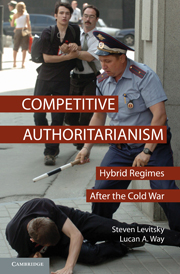Book contents
- Frontmatter
- Contents
- Acknowledgments
- Acronyms and Abbreviations
- Part I Introduction and Theory
- Part II High Linkage and Democratization: Eastern Europe and the Americas
- Part III The Dynamics of Competitive Authoritarianism in Low-Linkage Regions: The Former Soviet Union, Africa, and Asia
- 5 The Evolution of Post-Soviet Competitive Authoritarianism
- 6 Africa: Transitions without Democratization
- 7 Diverging Outcomes in Asia
- 8 Conclusion
- Appendix I Measuring Competitive Authoritarianism and Authoritarian Stability
- Appendix II Measuring Leverage
- Appendix III Measuring Linkage
- Appendix IV Measuring Organizational Power
- References
- Index
7 - Diverging Outcomes in Asia
Published online by Cambridge University Press: 05 June 2012
- Frontmatter
- Contents
- Acknowledgments
- Acronyms and Abbreviations
- Part I Introduction and Theory
- Part II High Linkage and Democratization: Eastern Europe and the Americas
- Part III The Dynamics of Competitive Authoritarianism in Low-Linkage Regions: The Former Soviet Union, Africa, and Asia
- 5 The Evolution of Post-Soviet Competitive Authoritarianism
- 6 Africa: Transitions without Democratization
- 7 Diverging Outcomes in Asia
- 8 Conclusion
- Appendix I Measuring Competitive Authoritarianism and Authoritarian Stability
- Appendix II Measuring Leverage
- Appendix III Measuring Linkage
- Appendix IV Measuring Organizational Power
- References
- Index
Summary
Our three Asian cases – Cambodia, Malaysia, and Taiwan – are diverse. Unlike the Americas or Eastern Europe, they did not share a common international environment. Western leverage was high in Cambodia but lower in Malaysia and Taiwan. Linkage ranged from low in Cambodia to medium in Malaysia to high in Taiwan. These differences had an important impact on regime trajectories. In Malaysia and Taiwan, ruling parties possessed considerable organizational power. However, whereas the Malaysian government used its coercive capacity to thwart opposition challenges at relatively low external cost, Taiwan's high linkage – and distinctive need to retain its international standing with the United States – induced the KMT government to underutilize its coercive capacity, which eventually led to democratization. In Cambodia, where state and party structures were weaker and Western leverage was higher, external intervention nearly dislodged the former communists from power in 1993. Over time, however, international attention faded, and within this more permissive international environment, effective state- and party-building permitted authoritarian reconsolidation.
TAIWAN
Taiwan's democratization was, in part, a story of modernization. Industrialization under the Kuomintang (KMT) led to the growth of a large middle class and a vigorous civil society, which eventually undermined single-party rule. Yet Taiwan's democratization also had a top-down character. Indeed, many scholars have highlighted the role of Presidents Chiang Ching-kuo and Lee Teng-hui in initiating and carrying out political reform.
- Type
- Chapter
- Information
- Competitive AuthoritarianismHybrid Regimes after the Cold War, pp. 309 - 338Publisher: Cambridge University PressPrint publication year: 2010



